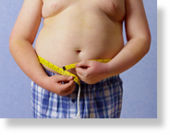In the largest study of childhood obesity ever conducted in the city, 40% of kindergartners through eighth-graders - more than 250,000 kids - were found to be too heavy.
Officials say even though the data seem startling, the rate of obesity in city kids is actually flat-lining, while it's rising nationwide.
"While it would be great if we saw the numbers go down, it is encouraging that they're holding steady," said Laurie Benson, executive director of the Department of Education's Office of School Wellness, refering to previous studies with smaller sample sizes.
The report, based on Fitnessgram assessments of more than 635,000 kids in eighth grade or lower, showed wide variation in obesity levels throughout different neighborhoods.
In the upper West Side zip code of 10069, less than 12% of kids were found to be obese or overweight. But in Corona's 11368, a shocking 51% of kids were found to be too heavy.
"I'm not surprised," said Corona mom Leslie Rivera, 34, whose 7-year-old son, George, is entering the second grade at Public School 13. "There's so much fast food around here."
Gabriella Mendoza, 39, while dining with her 6-year-old son Kevin at a Corona McDonald's, said she tries to carefully control his eating - but it's not always easy. "Sometimes I bring him here, but not often because I know it's too much calories," Mendoza said.
Among the report's additional alarming findings:
About 48% of children in two Central Harlem/Morningside Heights zip codes - 10037 and 10039 - are too heavy.City officials conceded that the dramatic geographic divide is disappointing but not surprising.
About 47% of kids in four zip codes in Washington Heights/Inwood - 10031, 10040, 10033, 10032 - are overweight or obese.
More than 46% of youngsters in Williamsburg/Bushwick's 11237 and East Harlem's 10029 are carrying too much weight.
"If you look at the adult levels of obesity, you're going to see very similar trends," Benson said. "Unfortunately, there is a lot of correlation between socioeconomics and health status."
Kathy Nonas, director of physical activity and nutrition programs at the Department of Health, stressed that the data show the city's effort to tackle poor health among schoolchildren is showing results.
She pointed to measures such as eliminating sugary drinks from school vending machines, offering healthier lunches and increasing physical activity. The data shows that "we're doing something right," Nonas said. "It also tells us that we have a lot more to do in order to get this down."
The departments of health and education compiled the data by examining the "Fitnessgrams," personal health evaluations based on strength, endurance, flexibility and body mass index.
The fitness report cards have been used to assess student health and offer specific tips since 2006, but the number of students participating in the program has increased every year.
"This helps us see whether the initiatives that we've put in are having some effect," Nonas said.




Reader Comments
to our Newsletter